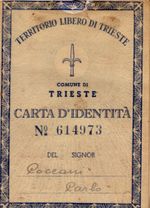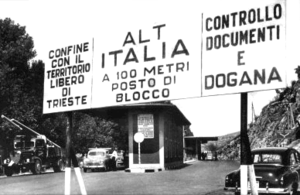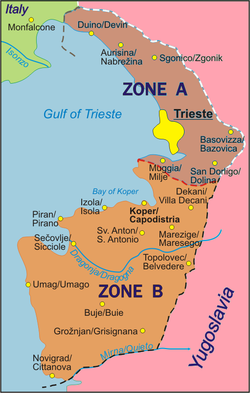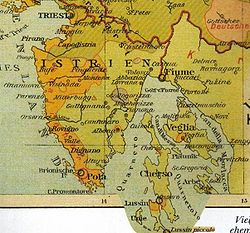Free Territory of Trieste
|
|||||||||||||||||||||||||||||||||||||||||||||||
The Free Territory of Trieste (Italian: Territorio libero di Trieste, Slovene: Svobodno tržaško ozemlje, Croatian: Slobodni teritorij Trsta) was to be a city-state situated in Central Europe between northern Italy and Yugoslavia, created by the United Nations Security Council in the aftermath of World War II and provisionally administered by an appointed military governor commanding the peacekeeping United Nations Protection Force forces stationed there.
The Free Territory was decided on 10 February 1947 by a protocol of the Italian Peace Treaty in order to accommodate an ethnically and culturally mixed population in a neutral independent country. The intention was also to cool down territorial claims between Italy and Yugoslavia, due to its strategic importance for trade with Central Europe. It came into existence on 15 September 1947. It was divided into two zones: one being the port city of Trieste with a narrow coastal strip to the north west (Zone A); the other, larger (Zone B) was formed by a small portion north-western of the Istrian peninsula.
The Free Territory was eventually taken over by its two neighbors in 1954 and officially dissolved by the Treaty of Osimo of 1975.
Contents |
Geography

The Free Territory of Trieste comprised an area of 738 km² around the Bay of Trieste from Duino/Devin in the north to Novigrad/Cittanova in the south, and had approximately 330,000 inhabitants. It bordered Italy to the north and Yugoslavia to the south and east. The rivers of the territory included the Rižana/Risano, the Dragonja/Dragogna, the Timavo/Timava, the Rosandra/Glinščica and the Mirna/Quieto. The Territory's highest point was at Monte Cocusso/Kokoš (668 m). Its most extreme points were near Medeazza/Medja vas at 45° 48’ in the north, at Tarski/Porto Quieto at 45° 18’ in the south, Savudrija/Punta Salvore at 13° 29’ in the west and Gročana/Grozzana at 13° 55’ in the east.
History
Since 1382, Trieste had been part of the Habsburg monarchy, whilst Istria had been for centuries divided between the Habsburg Monarchy (its central, northern and eastern parts) and the Republic of Venice (its western and southern parts). The population of the FTT has historically been diverse and mixed, with different and often changing ethnic majorities in different parts of the territory. Italians have so been predominant in most urban settlements and in the coast with strong minorities of Slovenes or Croats, especially in Trieste/Trst district where Slovenes represented a third of the population by the end of World War One. The countryside of the territory was mostly Slovene or Croatian in the southernmost portion of the area. However there was also a smaller number of semi-nomadic Istro-Romanians and a strong Triestine Jewish community.
In 1921 (after World War I) Italy formally annexed Trieste, Istria and part of modern-day western Slovenia, establishing the border region known as the Julian March (Venezia Giulia). In 1924 Italy further annexed the Free State of Fiume, now the city of Rijeka in Croatia.
During the 1920s and 1930s the Slavic population was subjected to forced Italianization and discrimination under the Italian Fascist regime. They were also exposed to state sponsored violence by fascist party mobs, including the burning of the Slovene National House in Trieste on July 13, 1920 and also in other towns and villages. Many Slovenes and Croats consequentially emigrated to Yugoslavia, while some joined the TIGR resistance organization, whose methods included more than 100 violent actions against the exponents of the regime in the region (especially in the Provinces of Trieste and Gorizia), considered as acts of terrorism by the Italian state.
World War II
Italy fought with the Axis powers in World War II. When the Fascist regime collapsed in 1943 and Italy capitulated, the territory was occupied by German forces, Italian Social Republic authority in this zone being largely theoretical. The Yugoslav 4th Army together with the Slovenian 9th Corps entered Trieste on May 1, 1945. The 2nd Division (New Zealand) of the British 8th Army arrived on the next day and forced the surrender of 2,000 German Army troops holding out in Trieste which had refused to capitulate to partisan troops. An uneasy truce developed between Allied and Yugoslav troops occupying the area until British Gen. Sir William Morgan proposed a partition of the territory and the removal of Yugoslav troops from the area occupied by the Allies. Tito agreed in principle on May 23 as the British XIII Corps was moving forward to the proposed demarcation line. An agreement was signed in Duino on June 10, creating the Morgan Line. Yugoslav soldiers withdrew by June 12, 1945.[1]
Establishment of the territory

In January 1947 the United Nations Security Council approved Resolution 16 under Article 24 of its charter calling for the creation of a free state in Trieste and the region surrounding it. A permanent statute codifying its provisions was to become recognized under international law upon the appointment of an international governor approved by the Quatripartite Powers. On September 15, 1947, the peace treaty between the United Nations and Italy was ratified, establishing the Free Territory of Trieste. Official languages were Slovene, Italian and Croatian. However, the territory never received its planned self-government and it was maintained under military occupation respecting the division into two zones as decided by the Morgan Line: Zone A, which was 222.5 km² and had 262,406 residents including Trieste, was administered by British and American forces, while Zone B, which was 515.5 km² with 71,000 residents including north-western Istria, was administered by the Yugoslav National Army.

Between October 1947 and March 1948 the Soviet Union rejected the candidacy of 12 nominations for governor, at which point the Tripartite Powers (United States United Kingdom, and France) issued a note to Moscow and Belgrade on March 20, 1948 recommending that the territory be returned to Italian sovereignty. No governor was ever appointed under the terms of the UN Resolution. The Territory thus never functioned as a real independent state. Even so, its formal status was generally respected and it issued its own postage stamps. The break between the Tito government and the USSR in mid-1948 resulted in the proposal to return the territory to Italy being suspended until 1954.
The Allied Military Government administered Zone A, which was divided into peacekeeping and law enforcement sectors protected by a command of 5,000 Americans ("TRUST", the TRieste United States Troops) and 5,000 British in "BETFOR" (British Element Trieste FORce), each comprising a brigade-sized infantry force and complete support units (Signals, Engineers, Military Police, etc.).
The major TRUST unit was the 351st Infantry regiment composed of:
- Headquarters and headquarters company,
- Service company,
- Heavy mortar company,
- Tank company,
- Three infantry battalions each with three rifle companies andone heavy weapons company.
TRUST support units included:
- 88th Reconnaissance company,
- 12th Field Artillery battery,
- 517th Combat Engineer company,
- 281st Military Police Service company,
- 7106th Engineer Service company,
- 23rd Ordnance Maintenance company,
- 508th Signal company,
- 23rd Quartermaster company,
- 9th Transportation Truck company,
- 7th Station Hospital,
- 98th Army Band, and
- 7101st General Depot Headquarters company.[2]
According to the estimates published by the Allied Military Government, as of 1949 in the A zone there were about 310,000 inhabitants, including 239,200 Italians and 63,000 Slovenes. According to contemporary Italian sources, in zone B there were 36,000-55,000 Italians and 12,000-17,000 Slovenes and Croats. According to the Yugoslav census of 1945, which was considered falsified by the Quadripatite Commission set up by the United Nations,[3] in the part of Istria which was to become Zone B there were 67,461 inhabitants, including 30,789 Slovenes and Croats, 29,672 Italians and 7,000 people of unidentified nationality.
Dissolution
On 5 October 1954, the London Memorandum was signed in British capital by ministers of the United States, United Kingdom, Italy, and Yugoslavia. It gave former Zone A with Trieste to Italy for an ordinary civil administration, and Zone B, which had already incorporated a communist government since 1947, to Yugoslavia. In 1975 the bilateral Treaty of Osimo was signed in Osimo, definitively stopping respective claims over former Free Territory of Trieste by Italy and Yugoslavia.
Zone A corresponds to the current Italian Province of Trieste, and Zone B is now divided between the Slovenian Littoral and Croatian Istria.
Governors of the Territory
Zone A
- May 1, 1945 - July 4, 1945 Maj. Gen. Bernard Cyril Freyberg (New Zealand) *
- July 4, 1945 - July 4, 1947 Col. Alfred Connor Bowman (United States)*
- July 4, 1947 - September 16, 1947 Lt. Col. James J. Carnes (United States)*
- September 16, 1947 - May 31, 1951 Maj. Gen. Terence Sydney Airey (United Kingdom)
- May 31, 1951 - October 26, 1954 Maj. Gen. Thomas Winterton (United Kingdom)
Zone B
- May 1, 1945 - September 15, 1947 Dušan Kveder*
- September 15, 1947 - March 15, 1951 Mirko Lenac
- March 15, 1951 - October 26, 1954 Miloš Stamatović
*Governors of all Julian March prior to the establishment of the Territory.
- Source:Worldstatesmen / Italy / Trieste by Ben Cahoon
Demographics
During the late 1940s and in the years following the division of the territory, up to 40,000 people[4] (mostly Italians) chose to leave the Yugoslav B zone and move to the A zone or Italy for various reasons - some were intimidated into leaving and some simply preferred not to live in Yugoslavia. In Yugoslavia, the people who left were called optanti which translates as choosing, while they call themselves esuli or exiles. About 14,000 Italians chose to remain in the Yugoslav zone, now part of Slovenia and Croatia.
See also
- Treaty of peace with Italy (1947)
- Communist Party of the Free Territory of Trieste
- United Nations Security Council Resolution 16
- Julian March
- Istrian exodus
- Morgan Line
- Slovene Littoral
- Province of Trieste
- Slovenian Istria
- Istria County
References
- ↑ [1] [2]
- ↑ Trieste and the Free Territory of Trieste(FTT)1945-1954
- ↑ United States Intelligence Review, Issue 3, 28 February 1946
- ↑ Arrigo Petacco, The exodus. The story of the Italian population of Istria, Dalmatia, and Venezia Giulia, Mondadori, Milan, 1999. English translation.



